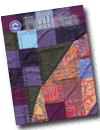
About this issue:
A Lively cultivation of creative writing excellence
At the “Mennonite/s Writing: An International Conference” held at Goshen College in October 2002 the 40th anniversary of the publication of Rudy Wiebe’s novel Peace Shall Destroy Many was acknowledged. The book, observed conference organizer and Professor of English Ervin Beck, initiated a remarkable development of Mennonite literature in the latter half of the 20th century.
The conference, the third to focus on Mennonite writers – the first was held at Conrad Grebel College in 1990, with the second at GC in 1997 – brought together more than 300 poets and essayists, teachers and students, fiction writers and literature lovers. They were welcomed at a college where professors, students and alumni have shared creative writing with the campus community since the dawn of the institution through the present.
In 1969, the English department, through then poet-in-residence Nick Lindsay, established Pinchpenny Press so students, faculty and friends of the college could publish low-cost, chapbook-sized books through a campus editorial board. Over the years, Lindsay produced numerous volumes, as did student Julia Spicher Kasdorf who has gone on to publish two poetry collections in her professional life, both well received in poetry circles; Jeff Gundy ’75, who is profiled in this edition of the Goshen College Bulletin; and Carmen Horst ’94, and David Waltner Toews ’71, whose poetry appears in this Bulletin issue. In 1998, Steve Yutzy ’98 edited a collection of Mennonite writing titled Greeting The Dawn: New Mennonite Writing. In 2003, Conrad Grebel professor Hildi Froese Tiessen, who chaired the most recent Mennonites Writing conference with Beck, printed a Pinchpenny tribute to Wiebe.
After Lindsay moved from Goshen in 1976 he continued to return to campus to lead poetry workshops, but the English department wished to have a constant creative writing presence and instituted Broadside, which prints poetry (often with illustrations) for a campus subscriber list. The first poem to be produced with the Broadside imprint was a poem titled “The Squirrel” by Frank Payne ’77, a physics major at GC who, according to Beck, “dealt with the traditionally unpoetic subject of a dead squirrel.” A complete collection of Broadsides reside in the Mennonite Historical Library.
In addition to providing its majors and minors with excellent academic preparation, the English department has welcomed students from other disciplines into writing courses and encouraged publication. With the influence of Goshen’s international education programs, the department expanded its offerings and publications took on the literary flavor of diverse cultures, questioning and exploring personal experience and universal understandings as the result of Study-Service Term and other encounters.
All this, and much more, makes for a rich environment in which to root strong writers among us. In this issue, we take our cues from new book titles and an appreciation of attention by writers to considering Mennonite heritage and modern explorations in an era of prolific and strong writing from Goshen College alumni.



 About this issue:
About this issue: 